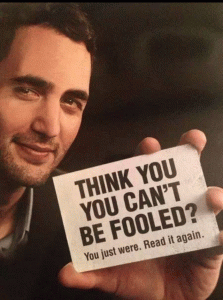Proofreading is a bitch. Typos are the bane of my existence. So how are you expected to proof your own work after you’ve just spent an hour or (heaven forbid) hours staring at it? One of the best techniques that every proof reader knows about is reading your copy backwards. This can be very effective, and if you don’t already employ this technique, I highly recommend it. However reading your text to yourself backwards has its limitations.
In this article I’m going to explain a better way to proof your work by using some of the more human qualities found on your computer.
We all know that most modern computers handily underline your spelling mistakes as they happen. I blame this feature for the utter deterioration of my skelling spills. 😉 But computers can’t pick up everything. What if you used father in a sentence but meant to use farther? Neither will be underlined. Or what about special words that ARE underlined but correct like when you wrote McCreepy and meant to say McCreery. (Sorry Scotty). Will your computer honestly tell you when a sentence doesn’t make sense or isn’t Active? (Word tries, but has failed to be effective in my book).
Why is it so hard to proof your own work? You know how it is. You’ve just bled over that newsletter, blog post or article and you’ve read it and re-read it a thousand times. Then you give it to someone, and the first words out of their mouth are why did you spell Microsoft Microshift? Or banal anal? Or what were you trying to say with this paragraph?
Blame your brain.

Law of Closure
Take a look at the two illustrations on the right. You’ll see gaps. But does it matter? Obviously that doesn’t get in the way of your ability to recognize the square and a circle. Right? What you’re seeing are patterns and your brain is connecting the lines for you, automatically. That is what is referred to as the “Law of Closure.” (which should not be confused with finally receiving your divorce or burying a loved one).
Our brains have self-organizing tendencies that automatically fill in the gaps. That’s a nice way of saying your brains lie to your eyes. So while this auto-gap-filler-brain-thing is great when we’re driving a car, catching a ball, or voting for Republicans, what we’re seeing and what we’re perceiving are two different things than what’s actually on the paper…and that’s where typos come from.

Subjective Contours
To the right is another visual exercise. In this illustration (lifted from here) we see a representation of “Subjective Contours” In it you’ll see a white triangle, although clearly there is no white triangle present. Your brain makes the connection based on the patterns it recognizes. It closes the loop. Connects the dots. Fills in the walls. (There is no spoon Neo.).
Call it what you like, but at the end of the day the Law of Closure and Subjective Contours spell MISERY for you as a proof reader. While your eyes are scanning through your words to pickup on any typos, your brain is filling in the gaps. Care is Car. George is Gorge, commas and periods appear exactly where they should. Your brain doesn’t care that what you “meant” to put on the paper is totally different (or slightly different) from what you “actually” put on the paper. It sees only what it wants to see, or what it expects to see! According to your brain everything is “A-OK”. This is a lie. How’s this for a News Flash! Your brain is working against you to keep its friend, your enemy, the typo alive.
It’s time to take control of your lying, cheating brain and kick some Gestalt ass. You need to TRICK your brain into being a better proofer helper. Seriously, another great way to detect errors in your copy isn’t with a bitchen set of books from Chicago and the AP, although those are good to have. What you need is a good set of ears. One ear will do if that’s all you got.
When proofing, our ears can pick up on subtle problems within the text that our eyes and brain conspire to miss. So how do you get your copy read to you? It’s not like you’re going to be able to ask someone to do it, unless you pay them. To the rescue is Apple’s text to speech feature built into OS X.
I have no idea what the origins of Apple’s text to speech are, but I’d like to give the person(s) that thought it up a big wet kiss. Speech is my #1 way of proofing what I write. (Hopefully you find few if any typos in this article!!!)
Here is all you have to do to engage Apple’s text to speech feature on your Mac.
Select the copy you want to have read to you. NOTE: this works in Pages, TextEdit and most writing programs on the Mac. I don’t yet see this feature in WORD. Duh. So right-mouse click on it. Click Speech. Click Start Speaking. Your computer will automatically convert the highlighted text into the spoken word. Now, if you haven’t played with this feature before, you might want to change the voice that your computer uses. You can do this in System Preferences. Click on the Speech microphone. Make sure ALEX is selected. He’s the best. He gives you the most natural sounding reading you’ll find natively on the Mac.
Now that you have Alex reading your text to you, listen to him. Listen carefully. He’ll help you pick up on problems with punctuation and spelling. Yes, sometimes Alex bobbles a word, like Live and Live. Ok, he’s not exactly good at context. That’s fine with me. What he is good at picking up is problems with your sentence structure, typos and punctuation. Now my brain is forced to experience my copy in a whole new way.
Here, you can play an example of an earlier paragraph from this article. I recorded this out of TextEdit using WireTap Studio.
By listening to what you’ve written you have a better chance of picking out the problems. Today I actually had my computer read back the outline of a new story I’m working on. It took 22 minutes. I was able to record that reading and synch it to my iPhone. Then during my hike this morning I was able to listen to my words read back to me. It was really cool. I brought along a small tape recorder so that I could make note of changes.
Now before you send or post that copy, listen to it. Hear the problems. Hear where your punctuation is off or where you used the incorrect word. You’ll be amazed at how much cleaner your copy can be because of Alex. Of course you could always stick to reading your copy backwards, but then again that’s really not practical while hiking.


May 22, 2011
No Comments
By Scott